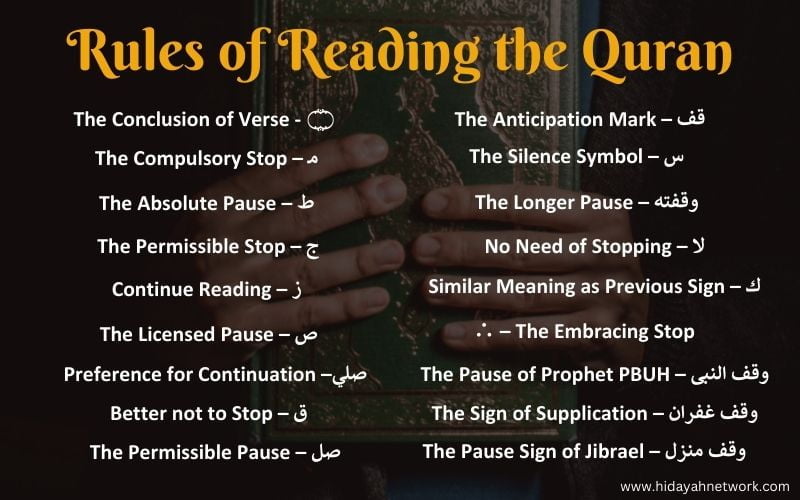Complete Quran Reading Rules

- Hidayah
- Network
- | Role: Hidayah Network

Following the rules of reading the Quran is of utmost importance for Muslims. It ensures the proper recitation and understanding of the holy book, and also strengthens the spiritual connection with Allah SWT.
Reciting the Quran with the correct pronunciation and tajweed rules ensures that its true message is conveyed. Following these rules helps Muslims to deepen their faith and strengthen their relationship with God.
The first and most important rule is to purify oneself before reading or learning Quran by performing Wudhu or washing oneself.
Table of Contents
Toggle18 Rules of Reading the Quran
Herer are the 18 important rules of reading the Quran provided by Hidayah Network professional quran tutors in there online quran recitation course.
1. The Conclusion of Verse
The conclusion of an Ayah (verse) in the Quran is denoted by a small pause called a sukoon. It is recommended for readers to pause briefly at the end of an ayah to reflect on its meaning and significance.
Reciting the Quran with proper pronunciation, intonation, and pausing at the appropriate places is considered essential for fully experiencing the spiritual impact of the Quranic recitation.
2. مـ – The Compulsory Stop
The letter “م” (Meem) is one of the letters associated with the compulsory stop (waqf) in Quranic recitation.
The compulsory stop is a pause that is required when reciting certain verses of the Quran, as dictated by the rules of tajweed. It is very important to take this pause, otherwise, the meaning of the verse can be changed.
In some cases, the compulsory stop can occur at the end of a word, while in other cases, it may occur in the middle of a word.
Get 40% OFF Now!
3. ط – The Absolute Pause
In Arabic, the symbol “ط” is known as the “waqf e mutlaq” or “absolute pause” symbol. This symbol is used in the recitation of the Quran to indicate a complete stop in the reading process.
When a reader comes across this symbol, they are required to pause for a moment, take a breath, and then continue with the recitation. This pause is important for a number of reasons.
Firstly, it allows the reader to take a break and catch their breath, which is especially important during long recitations.
Secondly, it helps the reader to pace themselves and maintain a consistent rhythm throughout the recitation.
Finally, it serves as a visual marker that helps the reader to navigate through the text and avoid mistakes or errors in pronunciation.
4. ج – The Permissible Stop
The symbol “ج” in Arabic indicates a permissible stop, or “waqf e jaaiz”.
It signifies the completion of a thought or topic within a verse of the Quran, and prompts the reader to pause briefly before continuing. Although it is not obligatory to stop at this point, but it is important to do so, in order to fully understand the meaning of the preceding verses.
It provides a natural pause for the reader to take a breath and gather their thoughts before continuing.
5. ز – Continue Reading
The symbol “ز” in Arabic indicates a waqf e mujawwaz, which means “continue reading”. This sign indicates that the reader should not pause at this point and should instead continue reciting the Quran without any interruption. However, it is also important to note that stopping at this point is not forbidden and the reader may pause if needed.
6. ص – The Licensed Pause
The symbol “ص” in Arabic indicates a waqf e murakh-khas, which is a licensed pause. This sign signifies a specific type of pause that is permitted under certain circumstances. Unlike the waqf e jaaiz and waqf e mujawwaz, the waqf e murakh-khas is only used in specific cases where the reader needs to take a break due to fatigue or exhaustion.
This sign indicates that the reader may take a brief pause to rest and catch their breath before continuing with the recitation. It is important to note that this pause is only allowed if the reader is genuinely tired and needs a break. If the reader is able to continue without interruption, they should do so.
7. صلي– Preference for Continuation
The phrase “صلي” in Arabic indicates a rule of recitation known as al-wasl awlaa, which means “preference for continuation”. This rule is based on the principle that it is better to continue reciting the Quran without interruption, rather than pausing unnecessarily.
8. ق – Better not to Stop
The symbol “ق” in Arabic indicates a rule of recitation known as qeela ‘alayhil-waqf, which means “better not to stop”. This rule suggests that it is better to continue the Quran recitation without stopping at certain points, rather than pausing unnecessarily.
However, there are differing opinions among scholars on how to apply this rule in practice.
Some scholars argue that there are certain points in the Quranic text where it is appropriate to pause or stop briefly, even if the qeela ‘alayhil-waqf sign (stopping rules sign) appears. This may be done in order to better convey the intended meaning of the verses or to provide clarification or emphasis on specific points.
9. صل – The Permissible Pause
The symbol “صل” in Arabic indicates a rule of recitation known as qad yusal, which means “the permissible pause”. This rule allows the reciter to pause briefly at a certain point in the recitation, even though the symbol itself indicates that the recitation should continue.
It is important to note that the qad yusal sign does not indicate a mandatory stop or pause in the recitation, but rather a permissible one.
10. قف – The Anticipation Mark
In Arabic language, “قف” or “qif” is an anticipation mark that is used to indicate a pause or stop in a sentence where the reader might expect the sentence to continue without a pause. It is similar to a period or full stop in English, but it is specifically used to indicate a break or pause in a sentence that may not be immediately apparent to the reader.
11. س – The Silence Symbol
In Arabic language, “سكتة” or “saktah” is a symbol that is used to indicate a brief pause in a sentence, without actually breaking the breath. It is similar to a comma or a semicolon in English, but it is specifically used to indicate a short pause that does not require a breath.
The use of “saktah” is common in formal written and spoken Arabic, where it is used to create a sense of rhythm and flow in the sentence. It is also used to indicate a change in emphasis or tone within the sentence.
12. وقفتہ – The Longer Pause
In Arabic language, “وقفة” or “waqfah” is a symbol that is used to indicate a longer pause in a sentence, without actually breaking the flow of the sentence. It is similar to a period or a full stop in English, but it is specifically used to indicate a longer pause that does not require a breath.
13. لا – No Need of Stopping
In the context of the Quran, the word “لا” or “laa” is often used to indicate negation or denial, and it is not a punctuation mark that requires a pause or a stop. Unlike other Arabic punctuation marks, “laa” is not used to indicate a break in the flow of the sentence, but rather to provide emphasis or to negate a statement.
It is important to note that when “laa” is used within a Quranic verse, it should not be treated as a punctuation mark that requires a pause or a stop.
14. ك – Similar Meaning as Previous Sign
In Arabic language, the word “كذلك” or “kadhaalik” is used to indicate that the action or statement that follows is similar to the one mentioned before it. It is similar to the English phrase “like that” or “in the same way”.
This symbol has the same connotation of action as mentioned by the symbol Laa.
15. ∴ – The Embracing Stop
The symbol here is called “Mu’anaqah” in Arabic, which means “embracing” or “entwining.” Mu’anaqah is a diacritical mark that is placed on the last letter of a word in the Quran to indicate that the reciter should stop and take a breath, but then continue immediately with the next verse.
The Quran is renowned for its eloquent and beautiful language, and the strategic placement of Mu’anaqah enhances the poetic and rhythmic flow of the verses.
16. وقف النبی – The Pause of Prophet PBUH
Waqf-un-Nabi, which translates to “the pause of the Prophet” is a Sunnah (an example set by the Prophet Muhammad SAW) that is followed in Quranic recitation. When reciting the Quran, Muslims aim to recite it in the same way that the Prophet Muhammad SAW recited it.
It is narrated that the Prophet Muhammad SAW, would pause or stop at certain points during his recitation of the Quran.
These pauses were not indicated by any specific symbol or diacritical mark, but rather they were based on the Prophet’s own recitation. These pauses are considered to be part of the Sunnah.
17. وقف غفران – The Sign of Supplication
“Waqf e Ghufraan” is an Arabic term that translates to “a pause for forgiveness.” This symbol is often used in Islamic texts, such as the Quran, to indicate to the reader that they should pause and seek forgiveness from Allah.
When a reader comes across this symbol while reciting the Quran or reading any Islamic text, they should stop reading immediately and recite a short prayer seeking forgiveness from Allah. This pause allows the reader to reflect on the message they have just read and seek forgiveness for any sins they may have committed.
18. وقف منزل – The Pause Sign of Jibrael
“Waqf e Manzil” is an Arabic term that translates to “pause at a designated place.” This symbol is used in the Quran to indicate a pause or stop that the Angel Jibrael would make when revealing Quranic verses to the Prophet Muhammad (PBUH).
When the Quran was being revealed to the Prophet Muhammad (PBUH), the Angel Jibreel would pause at certain points in the recitation, these designated pauses are marked in the Quran with the Waqf e Manzil symbol, which indicates to the reader that they should also pause and reflect.
Stopping Signs in Quran
- ⃝ – Waqf e Taam
- مـ – Waqf e Lazim
- ط – Waqf e Mutlaq
- ج – Waqf e Jaaiz
- ز – Waqf e Mujawwaz
- ص – Waqf e Murakh-Khas
- صلي – Al-Wasl Awlaa
- ق – Qeela ‘Alayhil-Waqf
- صل – Qad Yusal
- قف – Qif
- س – Saktah
- وقفتہ – Waqfah
- لا – Laa
- ك – Kadhaalik
- ∴ – Mu’anaqah
Conclusion
Here at Hidayah Network, our certified Arab Qaaris make sure to teach all types of the rules of the Holy Quran to their students, to ensure a perfect and proper recitation of the Holy Quran. If you are going to do hifz then get a proper online hifz course from certified and native arabic tutors.

About Author
